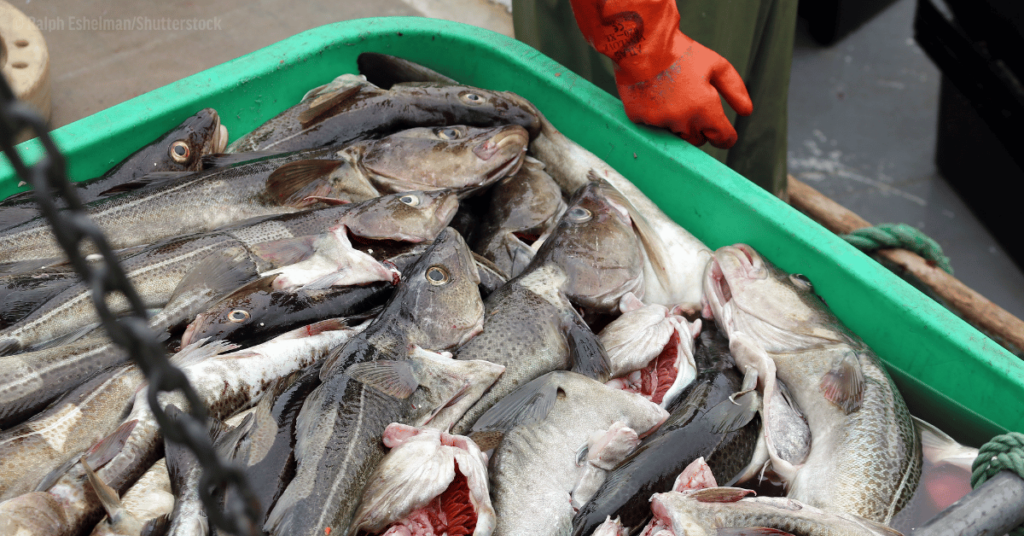March 26, 2025
Cod and Canada’s Seafood Economy: A Story of Decline, Recovery and Potential
Estimated reading time: 0 minutes
Canada’s seafood economy
Canada is a top global seafood exporter but relies heavily on only a few key species (snow crab, lobster, shrimp, and salmon) while most of the seafood Canadians eat is imported. Lacking diversity in healthy fisheries for market and relying on a few international trading partners creates an unstable, risky position. Canada’s seafood economy needs more thriving fisheries. Alarmingly, only 35% of Canada’s fish stocks are considered healthy, while mismanagement and overfishing persist. Allowing this state of fisheries to continue is a reckless gamble.
To secure the future of Canada’s seafood economy, we must rebuild stocks and diversify our fisheries. Canada has the tools to do this, if they are applied. Three iconic cod stocks illustrate Canada’s inconsistent approach to securing the future of fisheries; two (southern Newfoundland and northern Gulf) are on a path to rebuild, while one is being left behind.

A divided future for cod stocks
Atlantic cod are found across Eastern Canadian waters, but the biological populations are broken into different management units for regulatory purposes. Around Newfoundland and Labrador, cod stocks include northern Gulf (NAFO areas 3Pn4RS), southern Newfoundland (3Ps) and northern cod (2J3KL). Thanks to amendments to the Fisheries Act in 2019, depleted stocks require a plan to restore them to healthy levels.
Northern Gulf and southern Newfoundland cod finally have rebuilding plans. After 35 years of depletion, these stocks could recover in 8 to 13 years with new rebuilding plans.
While northern Gulf and southern Newfoundland stocks are now being managed to support their recovery, northern cod has been left in crisis with no targets, harvest rules or path to rebuild. Increasing industrial fishing pressure on northern cod, against scientific advice, is causing the population to decline faster, all while its primary food source, capelin, are scarce. Capelin have historically low population levels but continue to face fishing pressure. But we know that rebuilding capelin would support cod’s recovery. Studies show a fully rebuilt northern cod fishery could create 16 times more jobs and increase its value fivefold. Currently, the stock remains trapped in a cycle of mismanagement, squandering valuable time and resources that should be used for rebuilding—ultimately short-changing the fishing industry.
Rebuilding northern cod
Canada can bring abundant, high-quality cod to market, harvested from healthy fish populations, thriving oceans, and responsibly managed fisheries. This requires a bold shift away from the failed fisheries management of the past. Northern Gulf and southern Newfoundland cod stocks are already showing promising steps for recovery, but northern cod, and other depleted populations like capelin, cannot be ignored.
As global demand for high-quality fish rises, Canada’s seafood sector must mitigate risks and plan for long-term resilience. To secure the future of key species like cod, Canada must fully leverage the tools and strategies at its disposal. Reckless, short-term decisions and tolerance for mismanagement are no longer an option. Especially when a more resilient and prosperous future is within our reach.
Join Oceana Canada in supporting a sustainable seafood economy and calling for science-based management to rebuild fish populations like northern cod. Become a Wavemaker today for ways to take action! Together, we can save the oceans and feed the world. >>
MOST RECENT
April 24, 2025
March 6, 2025
February 3, 2025
January 22, 2025
Celebrating New Beginnings in 2025: Four Right Whale Calves Spotted Off Florida Coast

